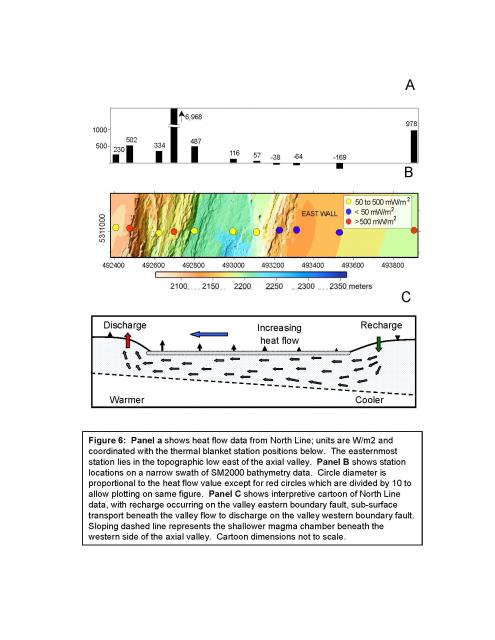Tivey
One of the fundamental questions articulated in the original Ridge2000 Integrated Study Site implementation plans (e.g. http://www.ridge2000.org/science/downloads/endeavour/endeavour_ip.pdf) was “What are the major pathways and timescales of hydrothermal fluid circulation from recharge to discharge and what controls the location, intensity, magnitude, and style of hydrothermal venting along the segment?” Despite a number of successes in numerically simulating various aspects of hydrothermal circulation systems at midocean ridges (MORs), there has been little or no direct, or indeed indirect, observation of the pattern of subsurface hydrothermal circulation at a MOR spreading center. High resolution multibeam bathymetry has allowed us to document the location and volume of hydrothermal discharge structures and vent deposits within MORs and to define the relationship between these features and their tectonic and volcanic setting. Subsurface imaging of upflow zones, while difficult has been shown to produce discrete zones of reduced magnetization i.e. “magnetic burn–holes” that persist in the geologic record and provide clues as to the size and geometry of this part of the subsurface fluid pathway. In contrast, constraining where the zones of fluid recharge are is a more intrinsically difficult measurement/observation to document. Recent success with conductive heat flow measurements using bare-rock thermal blanket technology (Johnson et al., 2010) provides a possible method of addressing this latter issue. A prototype deployment of thermal blankets at the Main Endeavour Field on the Juan de Fuca produced results that imply that there are multiple scales of subsurface hydrothermal circulation present at the mid-ocean spreading center. At the scale of the axial rift valley or axial trough, there appears to be strong control from the bounding rift valley fault systems. The MEF thermal blanket survey shows a strong trend in conductive heat flux increasing from east to west across the rift axis with apparent recharge in the east and observed high temperature discharge on the western side. This across axis trend in heat flow mirrors the observed difference in depth to the seismically imaged top of the axial magma chamber, which is deeper in the east and shallows to the west. Superimposed on this overall pattern appears to be more local fluid circulation paths in annular-like patterns of recharge (low heat flow) around major vent areas and other less well-defined zones of local recharge at fault zones within the MEF rift. It is a clear that there is close interplay between hydrothermal circulation and parameters such as crustal structure, the depth of the magma chamber and tectonic stress in terms of faults and fissuring. Knowledge of the distribution of faults, fissures, the volcanic architecture and the depth to the axial magma chamber are all key parameters in driving the pattern of hydrothermal circulation at a MOR. In situ measurements of conductive heat flux using the thermal blanket instruments allows us to make this connection more definitive and to test more realistic 3D simulations of hydrothermal circulation in these environments.
REFERENCES
Johnson, H.P., M.A. Tivey, T.A. Bjorkland and M.S. Salmi, Hydrothermal circulation within the Endeavour Segment; Juan de Fuca Ridge, Geochem. Geophys. Geosyst., 11(5), Q05002, doi:10.1029/2009GC002957, 2010.

